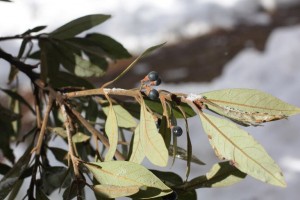Swamp Bay: February 2016 Wildflower of the Month
 Most evergreen trees in the Coastal Plain have needle-like leaves. The magnolias are exceptions and so is Swamp Bay, which has narrow, dark green leaves. They are strongly aromatic, somewhat leathery, and wedge-shaped at the base. Shiny on top and pale green beneath, the leaves have upright rusty-colored hairs on their midveins. Swamp Bay closely resembles Sweetbay (Magnolia virginiana) but the leaves of Sweetbay are whitened beneath.
Most evergreen trees in the Coastal Plain have needle-like leaves. The magnolias are exceptions and so is Swamp Bay, which has narrow, dark green leaves. They are strongly aromatic, somewhat leathery, and wedge-shaped at the base. Shiny on top and pale green beneath, the leaves have upright rusty-colored hairs on their midveins. Swamp Bay closely resembles Sweetbay (Magnolia virginiana) but the leaves of Sweetbay are whitened beneath.
The twigs are angled, and densely rusty-hairy. In May and June small flowers are borne in clusters on hairy stalks, producing small, dark blue to black roundish berries from September through October, on red stems. Bark is dark reddish and deeply grooved.
Swamp Bay is a tree of swamps and wet woods in the southern coastal states. In Virginia, it occurs in only 12 counties of the Coastal Plain, extending south from James City, Gloucester and Mathews counties. A large champion tree growing in a residential neighborhood in Newport News with a circumference of 155 inches, and 55 feet in height. A group of Swamp Bay grows in thickets near the start of the Jamestown Loop Road on Jamestown Island.
With an aroma similar to that of the European true laurel or bay tree, Laurus nobilis, the spicy leaves can be used to flavor soups and meats. Several species of birds eat the blue fruits of Swamp Bay, and the caterpillars of the Palamedes swallowtail butterfly feed on the leaves. A good place to see the Palamedes swallowtail is along Washington Ditch in the Great Dismal Swamp where Swamp Bay is common, and in the wet forests of Chesapeake and Virginia Beach
cities.
Swamp Bay is a member of the Laurel Family which includes Spicebush and Sassafras. The avocado (P. Americana) is another close relative, native to Central America.
By Helen Hamilton, past-president of the John Clayton Chapter, VNPS
Photo: Swamp Bay (Persea palustris) taken by Phillip Merritt
